2020 City vs Verna vs Rapid vs Vento vs Ciaz vs Yaris comparison
The mid-size sedan might have lost its lustre, but a revitalised field brings attention back to the segment. We reacquaint you with the options and zero in on the one car that does it all.
Published on Oct 17, 2020 06:00:00 AM
95,410 Views
Follow us on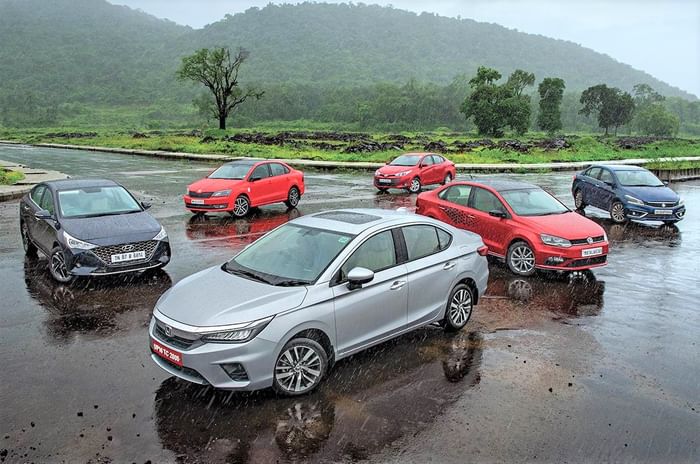

Sales in the segment might be on a steady decline, but carmakers sure haven’t given up on the mid-size sedan. There’s been a spurt of activity in the segment since the start of this year and while the contenders are familiar, much has changed since we last brought them all together.
The fifth-gen Honda City is the only ‘new’ car here, so to speak, and promises big by being the largest and most powerful petrol sedan in the segment. Hyundai’s Verna has also been rebooted for 2020, with revised styling, more features and a new 1.5-litre petrol engine. Incidentally, it’s a new petrol engine that has breathed fresh life into the quarrelling cousins, Skoda’s Rapid and Volkswagen’s Vento, which happen to be the oldest cars in the test. Not much has changed on the Maruti Suzuki Ciaz since its last update in 2018, but like the Rapid and Vento, it’s become a petrol-only model in the BS6 era. And finally, we have the Toyota Yaris that’s seen a variant revision and price rationalisation.
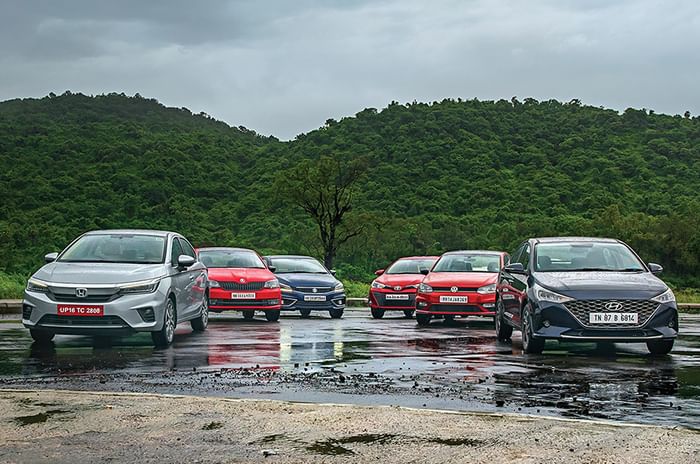
In consideration today are the petrol-manual versions of each, a spec that is available across all the models. In a break from format, we’ll be bunching up the cars into three pairs, comparing and contrasting each model with its most relevant rival before zooming out to deliver the verdict and the overall pick of the segment. Let the games begin.
| Hyundai Verna Price, Mileage, Specifications, Features and Variants | |
|---|---|
| Brand | Hyundai |
| Model Name | Verna |
| Hyundai Verna Price | ₹ 12.86 - 20.27 lakh |
| Hyundai Verna Range/Mileage | Petrol : 18.6 - 20.6kpl |
| Hyundai Verna Specifications | Sedan | 5 doors | 5 seats View All Specs |
| Hyundai Verna Features | LED headlight | 10.25-inch Touchscreen display | 6 airbags View All Features |
| Hyundai Verna Variants | 1.5 Petrol EX MT | 1.5 Petrol S MT | 1.5 Petrol SX MT View All Variants |
| Dimensions | ||||||
|---|---|---|---|---|---|---|
| Honda City 1.5 i-VTEC ZX | Hyundai Verna 1.5 MPI SX(O) | Skoda Rapid 1.0 TSI Monte Carlo | VW Vento 1.0 TSI Highline Plus | Maruti Ciaz 1.5 K15 Alpha | Toyota Yaris 1.5 V(Optional) | |
| L/W/H | 4549/1748/1489mm | 4440/1729/1475mm | 4413/1699/1466mm | 4390/1699/1467mm | 4490/1730/1485mm | 4425/1730/1495mm |
| Wheelbase | 2600mm | 2600mm | 2552mm | 2553mm | 2650mm | 2550mm |
| Kerb weight | 1153kg | 1185kg | 1138kg | 1138kg | 1060kg | 1120kg |
| Tyres | 185/55 R16 | 195/55 R16 | 195/55 R16 | 195/55 R16 | 195/55 R16 | 185/60 R15 |
| Boot capacity | 506 litres | 480 litres | 460 litres | 460 litres | 510 litres | 476 litres |
THE DESIRABLE ONES
It wouldn’t be overstating things to say the Honda City and Hyundai Verna have long been the most desirable of the mid-size sedans. There’s a premiumness to the packages that buyers are happy to pay relatively big money for. You’ve seen these models already, but standing tyre to tyre with the others, it’s the City that, importantly, looks like the largest car, which it is. The class-leading exterior dimensions translate into an incredibly airy cabin and earn the City commendation for rear-seat comfort, even before a wheel has been turned. Space at the back is superb, seat cushioning is excellent and the large windows also give you a great view out. If anything, the centre armrest is positioned too low for comfort. The City is just as nice up front. Those at the wheel will like the general layout of the dash, details like the air-con controls that click as you turn them, the part-digital dials and, of course, the excellent front seats. The soft-touch materials on the dash and door pads also help raise the ambience inside.

The Verna is the flashiest of all these cars and also strives to win you over with an interior that’s big on gadgets. Hyundai has packed in digital dials (they look better than they function), the 8.0-inch touchscreen is positioned to look larger than it is, and there’s wireless phone charging too. The Verna also has another talking point in its cool ventilated front seats. But for all its gizmos, there’s no escaping the fact that the Verna is down on space, even compared to some compact sedans, forget something like the City. Rear-seat legroom is in short supply, and the small windows don’t help the feeling of space either.
Before we get rolling, it’s important to bring in that both cars get new 1.5-litre naturally-aspirated petrol engines, but it’s Honda’s latest 121hp, 145Nm i-VTEC engine that is the more powerful one here. Those familiar with Honda’s older 1.5 will immediately note some differences in the new engine, perhaps made most evident with the shift from SOHC to DOHC. The new engine feels responsive right across the rev band (and not only once you pile on the revs, as in the last car) and this has granted the City a flexibility that was missing before. Part-throttle will see you through most of your city commutes (this also helps the City deliver class-best fuel economy) and the engine is so tractable that you can pull cleanly from 15kph in third gear. Just as well, because the clutch pedal’s high bite point makes it hard to modulate at really low speeds. The thing is, gearing on the City is tall and this reflects in roll-on timings, which is measured by mashing the accelerator down from a set speed.
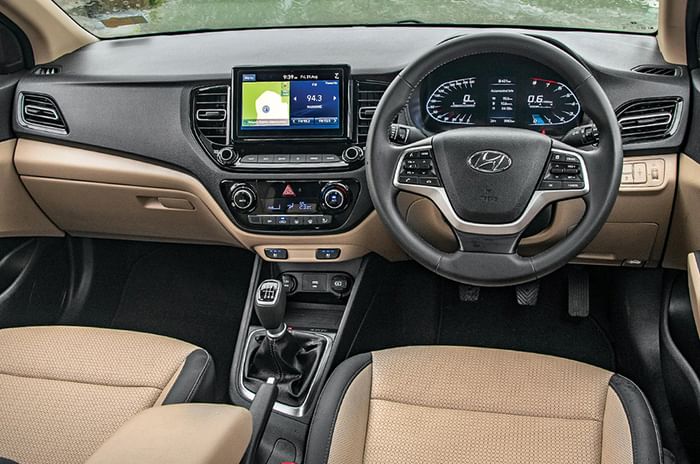
Also, given that even second gear maxes out at over 100kph, you’ll need a long, empty stretch to experience the pure joy of extending the engine to 7,000rpm. The trademark VTEC rush of power at the top end and the accompanying soundtrack do make such excursions properly rewarding, and it’s great fun charging through the 6-speed gearbox too. The City won’t disappoint on a drag strip either, with a 0-100kph time of 10.2sec.
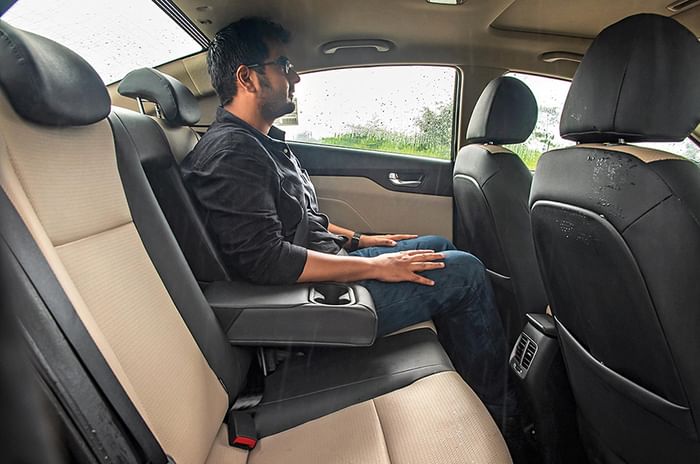
The Verna’s new 115hp, 144Nm, 1.5-litre, naturally aspirated petrol engine isn’t as multi-faceted as the City’s unit, and power and torque are down on the earlier Verna’s 1.6 petrol too. Still, there’s much to like about the new engine. Refinement, for one, is class leading, with just a murmur audible from the engine bay at typical city speeds. A smooth power delivery also makes the Verna very easy to live with in town. What’s more, it’s just as tractable as the City in gears two, three and four, and as an added plus, the Hyundai also has the more progressive clutch and lighter gearshifts. It’s just that on the open road, the engine’s lack of oomph in the mid-range becomes apparent. The build of power is unexciting and necessitates a downshift if you want to overtake in a hurry. Petrolheads had better look elsewhere for their thrills.
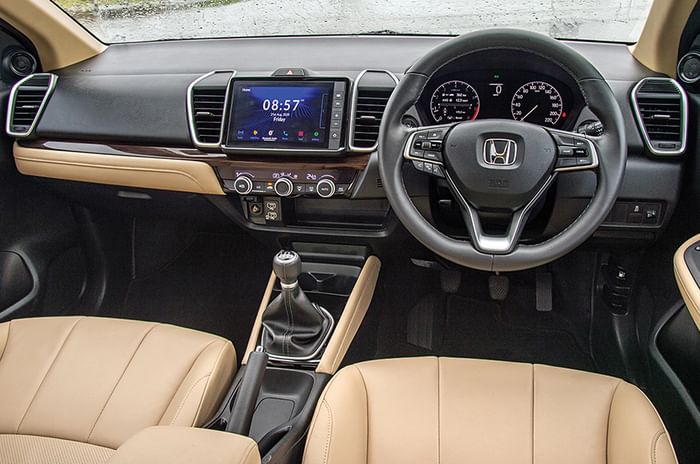
Of the other things, it’s the Verna’s suspension that works quieter across scenarios. True to Hyundai DNA, the Verna’s low-speed ride is supple, but the good news is high-speed stability is also impressive. Sure, this Verna petrol is still not as well set-up as the heavier diesel version, but it’s a more able long-distance machine than before. If only Hyundai could dial some more spice into the Verna’s steering too.
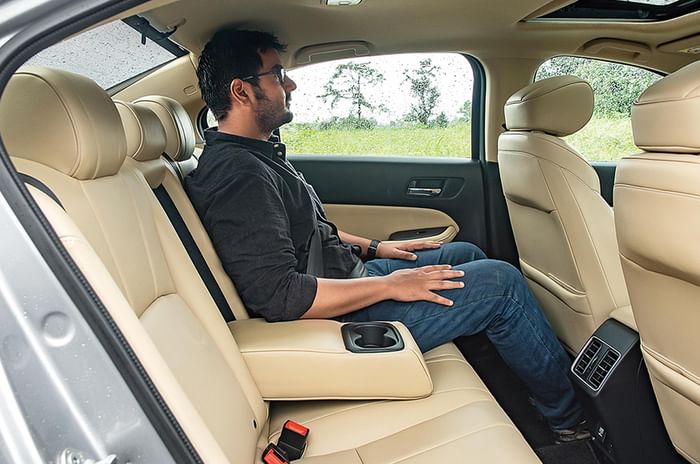
The Honda City is the keener handling sedan here. There is quite a bit of body roll in corners too, but turn-in is pleasant, the steering is responsive and even the slim, 185-section tyres hold on gamely. More pertinent is the fact that the comfort-oriented set-up has granted the City the cushiest low-speed ride among the mid-size sedans. The suspension transmits less of the happenings beneath and, even at speed, the high-frequency movements that were a constant in the last City are all but gone. Like the Verna, the City is planted at speeds as high as 120kph, but go any faster and you’ll need to keep a firm hand on the wheel to keep things in check.
THE SIBLINGS
The Skoda Rapid and Volkswagen Vento have had a long, long run in India so far, so you can think of the latest update as the last hurrah before the models make way for their replacements that come late next year. The best bit? The update is no sticker job, but centres around a brand-new engine. This 999cc, three-cylinder, direct-injection turbo-petrol unit is now the sole engine on offer in both sedans, and will power a whole range of models under the VW Group’s ambitious India 2.0 project.
Power is a fair 110hp, but it’s the 175Nm of torque that’s available from 1,750-4,000rpm that is the headline number here. And the mid-range is where it’s at in this duo; 2,000rpm gets the turbo spinning in earnest, and what you get thereon is a meaty slug of torque well past 6,000rpm. Suffice to say, that strong surge in power can convert the most ardent advocates of natural aspiration.
The punchy power delivery is addictive and you’ll find yourself overtaking cars just because of the ease with which you can. The TSI-powered siblings are easily the quickest here in overtaking scenarios, be it 50-70kph in third, 60-80kph in fourth or even 80-100kph in fifth.
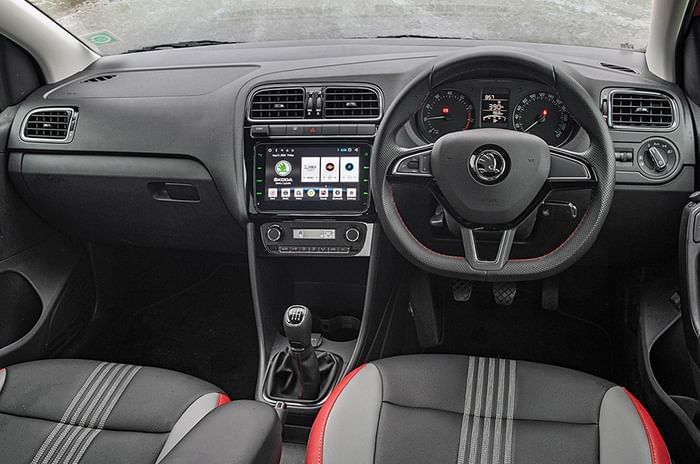
The Skoda Rapid TSI also holds the distinction of being the fastest car here from standstill to 100kph, with a time of 10.09sec. Interestingly, the Vento (10.42sec) is not only a touch slower than the Rapid to 100kph but is also marginally slower through the gears. Driving the cars back to back revealed the Vento to be that wee bit gentler in its build of power, where the Rapid feels more forceful when the turbo kicks in. You also hear a smidgen more of the engine in the Vento. The engines aren’t loud, per se, and that three-pot thrum somehow lends character to the experience.
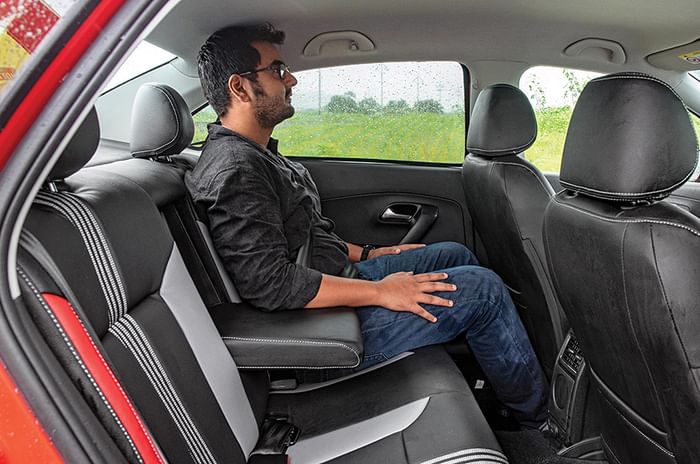
Entertaining as their engines are, the Rapid and Vento are also the most satisfying to pilot on a twisty road. There’s a nice weight to their steering and also enough feedback from the front wheels. Body control is great and, all in all, you feel confident to drive the cars hard. Out on the straights of a highway too, there’s a reassuring European heft with which the duo tackle long-wave undulations, even if there is some amount of pitching. Low-speed ride quality is good too, but on jagged potholes, you will hear the relatively stiffly damped Skoda and VW’s suspension protest with a loud thwack.
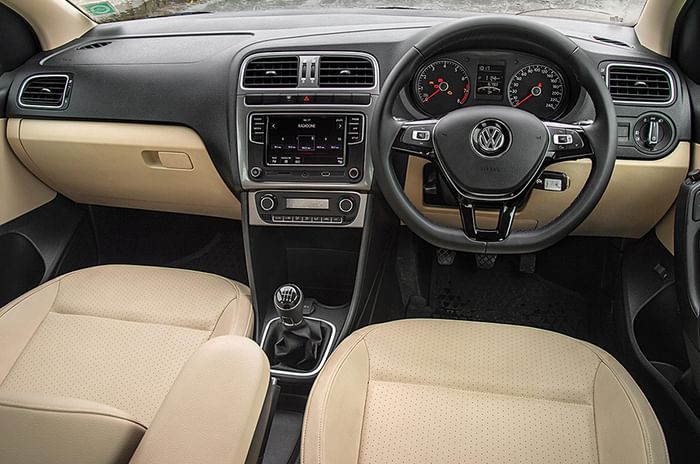
In everyday driving situations, you’ll have to be mindful of being in the right gear in the Rapid and Vento. The engine is fine for ambling along and part-throttle responses are fairly good too, but off-boost, the 1.0 unit lacks the low-end pulling power of its larger-hearted rivals. This need to use more throttle also reflects in the fuel economy numbers, with the Skoda and VW being the only cars to register single-digit figures in our city test cycle. Of the other things, the clutch on both cars is well-weighted but a touch long in travel. And while keen drivers will love the mechanical feel of shifts on the 6-speed gearbox, some might find the action a bit notchy.
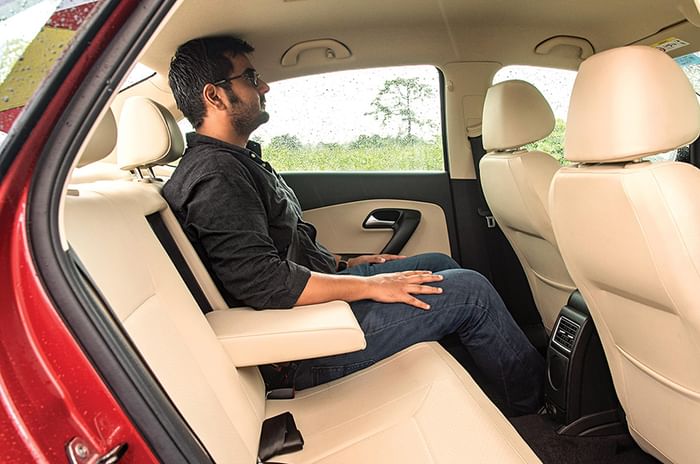
The needs of space and comfort are well addressed in the Rapid and Vento, but if there’s one thing these cars continue to stand out for, even today, it’s their solid build. Everything, from the ‘thunk’ on door shut and the flat-bottomed steering wheels, to the tactile window switches and even that rotary dial for the rear cabin lights, reeks quality. Steering wheels adjustable for rake and reach (standard across the board, as on the new City) also make it easy to get comfortable behind the wheel, but there’s no getting away from the fact that these are circa-2010 models fighting it out in 2020. The basic dials and simple dashboards simply lack flair. The range-topping Skoda Rapid Monte Carlo does distinguish itself with an all-black theme and red detailing, but the commemorative seat covers look decidedly aftermarket. Large windows and considerable legroom make the rear sections of the cabin a space two passengers will be happy to spend time in (but not three – blame the high centre tunnel). And if it’s you being chauffeured around in the Vento, you can maximise legroom for the ‘boss seat’ via a lever that lets you slide forward the front passenger seat from the back. Clever, right?
THE SENSIBLE ONES
If Maruti Suzuki is synonymous with value, nothing says trust like Toyota. The two like-minded carmakers have embarked on a partnership in India, as part of a global understanding, and have drawn plans to share models across segments. For the moment, however, the Maruti Ciaz goes up against the Toyota Yaris in the mid-size sedan space.
The Ciaz is well turned out and has the all-important big car look about it. The new City is both longer and wider than the Ciaz, but it’s the Maruti with the longest wheelbase, and this manifests in acres of legroom in the back. The Ciaz’s rear seat is also most accommodating for three adults. Sadly, the Ciaz can’t completely capitalise on this abundance of leg and shoulder room, thanks to a seat that’s far from perfect. The squab is short on thigh support, the seating position isn’t ideal and taller passengers will be restricted on headroom.
Up front, drivers of above-average height will also find the seat set too high, even at its lowest position. Save for the colour MID that shows the mild-hybrid system at work, there’s nothing out of the ordinary to the Ciaz’s driver environment. The dash is simple in design and quality levels are fair, though some of the switches come from lesser Marutis.
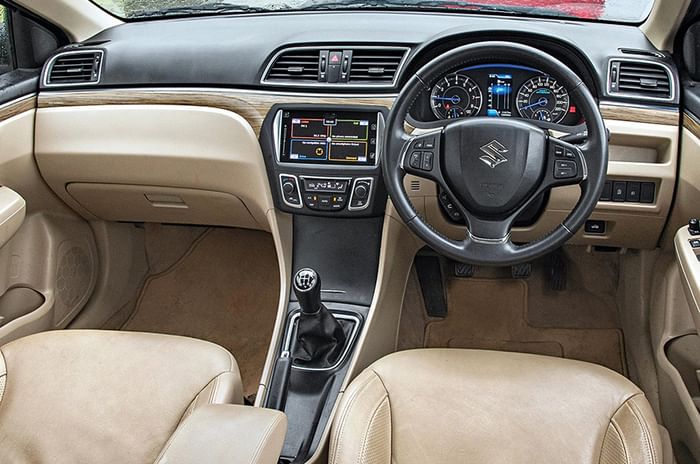
The Yaris’s exterior styling hasn’t found wide appreciation in India and the cabin has its hits and misses too. While the build comes across as tough, many of the plastics are underwhelming; the larger surfaces are hard, and the mock ‘stitching’ on the steering and dash is unconvincing. The dash is user-friendly, with the touchscreen (more on it later) positioned high up, and the large seats are also very comfortable. What you will have to make your peace with is the narrow footwell that lacks a dead pedal, offering no space to rest your left leg.
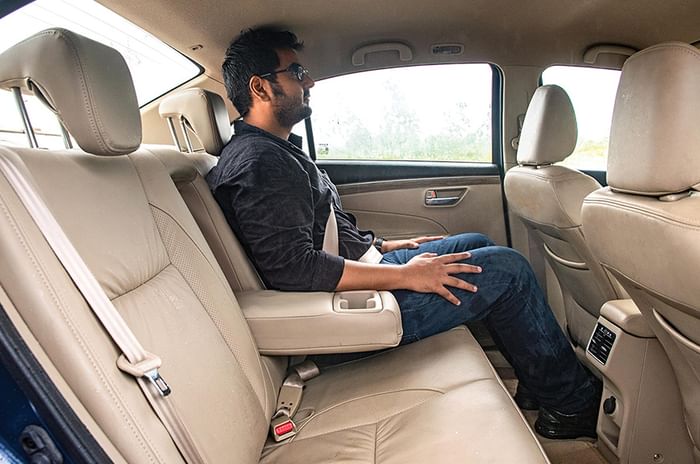
It’s a mixed bag at the back too. The Yaris is the only car with an adjustable rear centre headrest for the middle passenger. But the front centre armrest extends so far back, it actually eats into middle passenger legroom, and the backrest too is a bit upright. The MPV-like roof-mounted rear air-con vents are, however, the most effective at channelling cool air to the back, and it’s the only system that lets you adjust fan speed at the back too.
Neither of these cars sets the power charts on fire. With 105hp and 138Nm, the Ciaz’s 1.5-litre naturally-aspirated engine is actually the least powerful in the class. Then again, the engine only has to propel 1,060kg of car, which is also the least here. The light weight, cleverly chosen gear ratios and even gentle electric assist from the dual-battery, integrated starter generator-based mild-hybrid system come together to help the Ciaz deliver peppy performance in town. It is the quickest overall in the 20-80kph slog in third gear and also runs relatively close to the turbocharged pair in the 40-100kph roll-on run in fourth. A smooth gearbox, light clutch and well-contained engine noise also add to the Ciaz’s user-friendly nature. But, while it is a fair cruiser, you do miss the option of a sixth gear, something all other rivals offer.
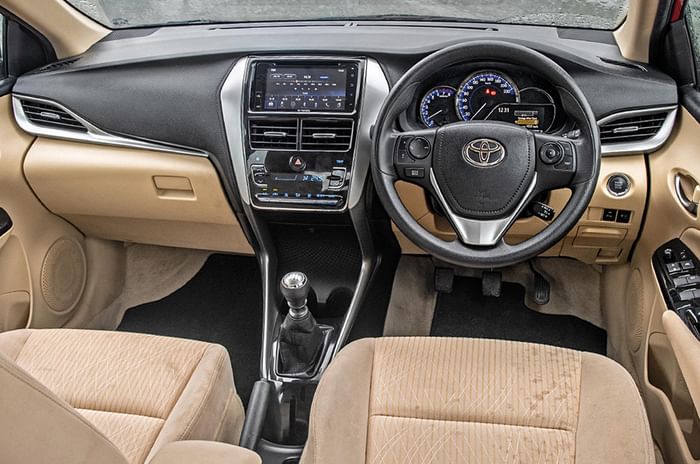
What the Ciaz’s engine is not, is exciting. The mid-range is flat and there’s no great change in character the harder you rev. Fact is, in the Ciaz, you see a clear priority for comfort over dynamism. Urban buyers, in particular, will like that the steering is light and easy to twirl at low speeds and will also appreciate how the suspension smoothens bad roads. Factor in a settled high-speed ride, and you get a comfortable car.
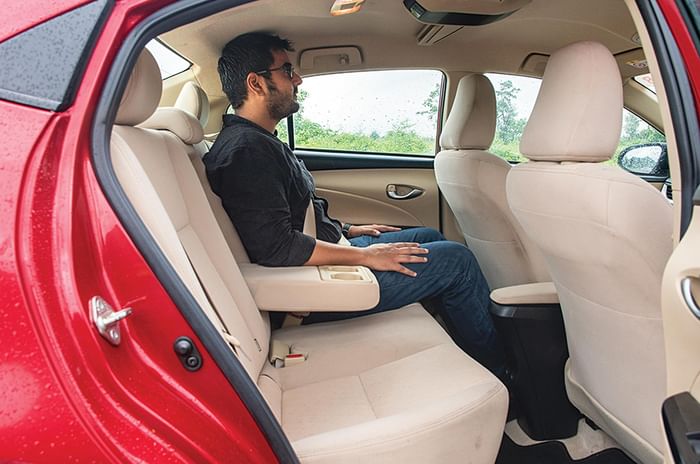
The 107hp and 140Nm Toyota Yaris just about noses ahead of the Ciaz in power and torque, but trails rivals in performance, both in outright acceleration and through the gears. The Yaris picks up speed smartly in town and performance is adequate to keep up with the flow of traffic. Ask any more of the engine, though, and it will leave you wanting. The mid-range is meek and you have to work the surprisingly sporty-shifting 6-speed gearbox to get the most out of the engine. Few will bother revving this engine hard, but doing so reveals the 1.5 naturally-aspirated unit gets a second wind around 5,800rpm or so. The fun is short-lived, however, as the rev limiter cuts in rather abruptly at 6,300rpm.
The Yaris’s humdrum engine and dull steering mean it isn’t a car that you’d be tempted to drive hard, but it’s reassuring to know that high-speed stability is good. Also upping confidence levels is the braking performance. The Toyota is the only car with rear discs and brake bite is really strong. In town, you will have to contend with a relatively heavy steering and also some firmness in the suspension.
| Engine and performance | ||||||
|---|---|---|---|---|---|---|
| Honda City 1.5 i-VTEC ZX | Hyundai Verna 1.5 MPI SX(O) | Skoda Rapid 1.0 TSI Monte Carlo | VW Vento 1.0 TSI Highline Plus | Maruti Ciaz 1.5 K15 Alpha | Toyota Yaris 1.5 V(Optional) | |
| Engine | 4-cyl, 1498cc, petrol | 4-cyl, 1497cc, petrol | 3-cyl, 999cc, turbo-petrol | 3-cyl, 999cc, turbo-petrol | 4-cyl, 1462cc, petrol mild-hybrid | 4-cyl, 1496cc, petrol |
| Power | 121hp at 6600rpm | 115hp at 6300rpm | 110hp at 5000-5500rpm | 110hp at 5000-5500rpm | 105hp at 6000rpm | 107hp at 6000rpm |
| Torque | 145Nm at 4300rpm | 144Nm at 4500rpm | 175Nm at 1750-4000rpm | 175Nm at 1750-4000rpm | 138Nm at 4400rpm | 140Nm at 4200rpm |
| Power to weight | 104.94hp per tonne | 97.04hp per tonne | 96.66hp per tonne | 96.66hp per tonne | 99.05hp per tonne | 95.53hp per tonne |
| Torque to weight | 125.75Nm per tonne | 121.51Nm per tonne | 153.77Nm per tonne | 153.77Nm per tonne | 130.18Nm per tonne | 125Nm per tonne |
| Gearbox | 6-speed manual | 6-speed manual | 6-speed manual | 6-speed manual | 5-speed manual | 6-speed manual |
| FUEL ECONOMY(KPL) | ||||||
| City/highway | 11.5/17.7 | 10.1/16.0 | 8.7/16.5 | 8.9/16.3 | 11.3/16.5 | 10.0/16.4 |
| PERFORMANCE: Acceleration from rest | Sec | Sec | Sec | Sec | Sec | Sec |
| 0-20kph | 1.17 | 1.21 | 1.19 | 1.31 | 1.25 | 1.13 |
| 0-40kph | 2.74 | 2.92 | 2.40 | 2.52 | 2.49 | 2.92 |
| 0-60kph | 4.53 | 5.39 | 4.36 | 4.49 | 4.77 | 5.33 |
| 0-80kph | 7.22 | 8.07 | 6.62 | 6.87 | 7.57 | 8.32 |
| 0-100kph | 10.20 | 12.03 | 10.09 | 10.42 | 11.23 | 12.39 |
| 0-120kph | 14.98 | 16.90 | 14.00 | 14.70 | 15.51 | 17.51 |
| 0-140kph | 20.71 | 23.90 | 19.60 | 20.66 | 22.44 | 25.06 |
| 0-160kph | 30.41 | 33.91 | 28.88 | 30.21 | 30.88 | 37.06 |
| ACCELERATION IN GEAR | ||||||
| 20-80kph (in third) | 13.23 | 13.11 | 11.69 | 12.79 | 10.86 | 14.74 |
| 50-70kph (in third) | 4.10 | 4.10 | 2.98 | 3.22 | 3.44 | 4.68 |
| 40-100kph (in fourth) | 18.23 | 18.25 | 14.38 | 14.61 | 15.69 | 20.43 |
| 60-80kph (in fourth) | 5.90 | 6.02 | 4.25 | 4.43 | 4.98 | 6.48 |
| 80-100kph (in fifth) | 7.21 | 7.67 | 5.73 | 5.94 | 13.74 | 8.94 |
| 80-100kph (in sixth) | 8.97 | 12.66 | 8.12 | 8.26 | --- | 11.77 |
FEATURE STORY
To simplify things, we’ve considered only the top-spec versions of each of the cars for this comparison and, as the features table makes clear, it’s the Honda City ZX and Hyundai Verna SX(O) that get the most goodies, albeit for a significantly higher outlay than rivals.
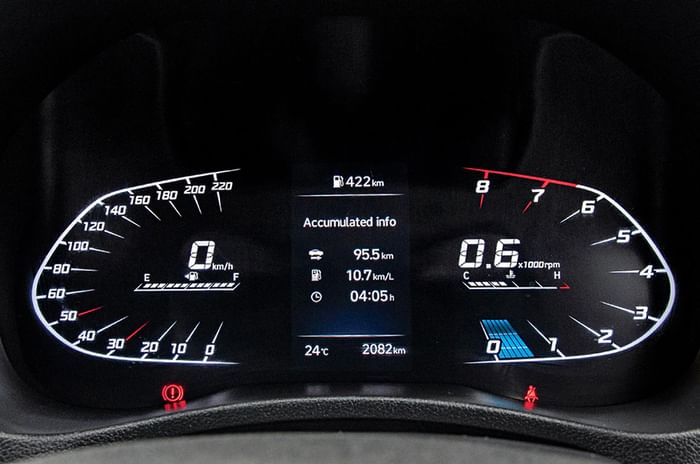
It’s the Verna with the most ‘wow’ features, with items like digital dials, wireless phone charging, ventilated front seats and even a hands-free boot release. Like the Verna, the City also gets a sunroof, but it’s the Honda with the better-executed digital instrument readout. The Honda also goes one-up on all its rivals with its handy Lane Watch camera that shows a video feed of the left-side blind spot on the centre screen. ESC, hill-start assist and tyre-pressure-monitoring systems are safety features only on the Verna and City, though it’s the Yaris V(O) with bragging rights when it comes to airbag count – seven, including a knee airbag, to the Verna and City’s six. The Toyota is also unique among petrol-manual mid-size sedans for its front parking sensors, split-folding rear seats (all cars do offer good room for luggage) and rear disc brakes. Sadly, the fully-loaded VX(O) trim has been withdrawn on the Yaris petrol-manual, and that means no factory-fit leather seats for the Toyota.
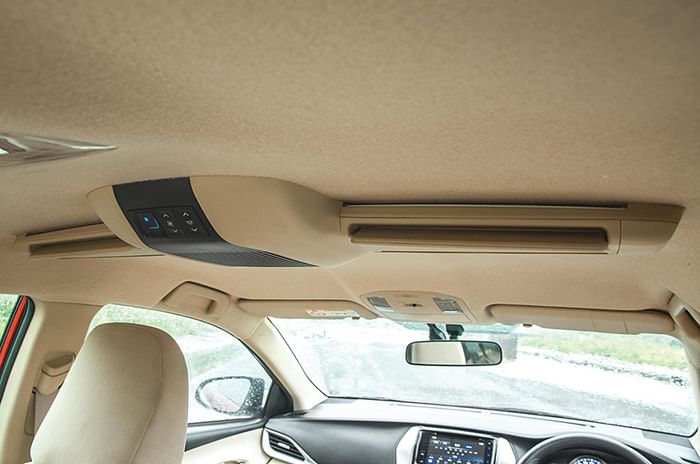
The Ciaz gets the comfort essentials, but only gets two airbags even in top-spec Alpha form. Curiously enough, while the second-from-top Rapid Style gets four airbags, the range-topping Rapid Monte Carlo trim gets only two. The special seat covers on the Monte Carlo are to blame for the omission of the side airbags. There are quirky feature differences between the Rapid and Vento too. Top versions of the Vento get LED headlights that are not offered on any version of the Rapid, but it’s only the Skoda that gets auto headlights. Both VW Group cars miss out on keyless entry and go.

In the battle of the infotainment systems, it’s the Verna’s 8.0-inch unit that comes out on top. It’s the easiest to use and gets the most features too. The City’s 8.0-inch unit is decent but the dim screen and low-res rear-view camera feed are spoilers. Top-spec versions of the Rapid get a high contrast 8.0-inch touchscreen which is slick and very responsive to touch inputs, but irritatingly, misses out on Android Auto and Apple CarPlay. We’re fans of VW’s stock 6.5-inch touchscreen system offered on the Vento, and also lower versions of the Rapid. The screen is relatively small and the high-set position of the USB port means your phone wire will always be dangling, but the interface is crisp and you also get smartphone mirroring options. The Ciaz’s SmartPlay system is nice enough, but you can expect Maruti to upgrade it to its latest (and nicer) SmartPlay Studio soon enough. Toyota’s 7.0-inch touchscreen won few admirers in our test team. It misses out on Android Auto and Apple CarPlay and also looks aftermarket.
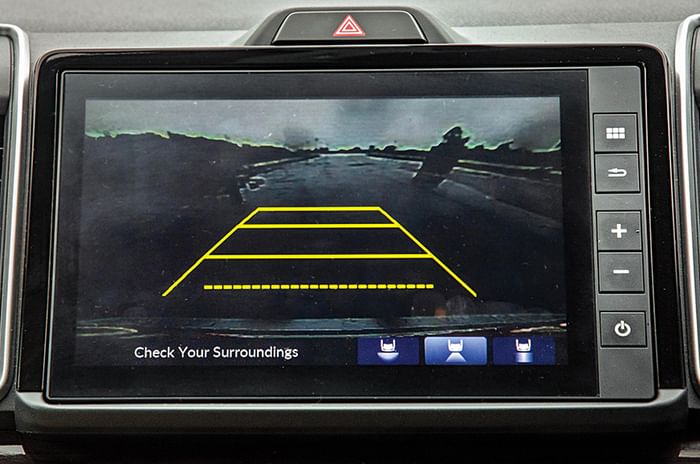
The Hyundai Verna and Honda City offer connected tech as standard, allowing you to remotely keep in touch with your car. Maruti offers a similar setup as a paid accessory.
| What you get for your money | ||||||
|---|---|---|---|---|---|---|
| Honda City 1.5 i-VTEC ZX | Hyundai Verna 1.5 MPI SX(O) | Skoda Rapid 1.0 TSI Monte Carlo | VW Vento 1.0 TSI Highline Plus | Maruti Suzuki Ciaz 1.5 K15 Alpha | Toyota Yaris 1.5 V(Optional) | |
| Price (ex-showroom, Delhi) | Rs 13.15 lakh | Rs 12.68 lakh | Rs 11.79 lakh | Rs 12.08 lakh | Rs 9.97 lakh | Rs 12.09 lakh |
| LED headlamps | Yes | Yes | NA | Yes | Yes | NA |
| Leather seats | Yes | Yes | NA | Yes | Yes | NA |
| Keyless entry and go | Yes | Yes | NA | NA | Yes | Yes |
| Steering adjust | Rake and reach | Rake and reach | Rake and reach | Rake and reach | Rake | Rake |
| Auto headlights/wipers | Yes/NA | Yes/NA | Yes/Yes | NA/Yes | Yes/NA | Yes/NA |
| Cruise control | Yes | Yes | Yes | Yes | Yes | Yes |
| Touchscreen | 8.0-inch | 8.0-inch | 8.0-inch | 6.5-inch | 7.0-inch | 7.0-inch |
| Android Auto/Apple CarPlay | Yes/Yes | Yes/Yes | NA | Yes/Yes | Yes/Yes | NA |
| Connected tech | Yes | Yes | NA | NA | NA | NA |
| Digital dials | Yes | Yes | NA | NA | NA | NA |
| Wireless phone charging | NA | Yes | NA | NA | NA | NA |
| Sunroof | Yes | Yes | NA | NA | NA | NA |
| Auto climate control | Yes | Yes | Yes | Yes | Yes | Yes |
| Ventilated front seats | NA | Yes | NA | NA | NA | NA |
| Rear AC vents | Yes | Yes | Yes | Yes | Yes | Yes |
| Front seat adjust from rear | NA | NA | NA | Yes | NA | NA |
| Rear sunscreen | Yes | Yes | NA | NA | Yes | NA |
| Hands-free boot release | NA | Yes | NA | NA | NA | NA |
| Rear-seat fold | NA | NA | NA | NA | NA | Yes |
| SAFETY FEATURES | ||||||
| Airbags | 6 | 6 | 2 | 4 | 2 | 7 |
| ESC | Yes | Yes | NA | NA | NA | NA |
| Camera | Rear and Lane Watch | Rear | Rear | Rear | Rear | Rear |
| Tyre pressure monitor | Yes | Yes | NA | NA | NA | NA |
| Parking sensors | Rear | Rear | Rear | Rear | Rear | Front and rear |
| Rear disc brakes | NA | NA | NA | NA | NA | Yes |
| ISOFIX child seat mounts | Yes | Yes | NA | NA | Yes | Yes |
PRICE DE RESISTANCE
Would you believe there’s more than a Rs 3-lakh gulf in prices between the most affordable and most expensive of these mid-size sedans! There is an option for every budget, but the models differ vastly in their value propositions.
Judged as a product, the Toyota Yaris (Rs 8.86-12.09 lakh; ex-showroom, Delhi) is a bit of a hard sell. The driving experience is plain vanilla and it’s a car that doesn’t top any section of the test. Reasons to be interested in one should centre around a guaranteed hassle-free ownership experience. Toyota’s new assured buyback programme also make the package that bit more enticing.

The Maruti Ciaz (Rs 8.32-9.98 lakh) is big and spacious, and its easy-going nature only adds to its appeal. Of course, the Ciaz also gets you the peace of mind of buying a Maruti. The thing is, the Ciaz makes for a level-headed choice but not an emotive one. Despite some clear strengths, the Ciaz simply doesn’t feel special enough.
If it’s a fun-to-drive sedan you are eyeing, then the Skoda Rapid (Rs 7.49-11.79 lakh) and Volkswagen Vento (Rs 8.93-12.08 lakh) are the cars you should be most interested in. The punchy 1.0 turbo engine makes everyday drives fun and the keen handling only adds to the experience. There’s little between the two cars, so it’s perhaps best to choose based on your proximity to a dealer; VW and Skoda have the smallest service network of the manufacturers here. Money no object, we’d pick the range-topping Vento Highline Plus (the LED headlights are the clincher). Tight on budget? Go for the incredibly-priced Rapid Rider and add to it as you can; your own project car, if you will. Do note, however, that opting for the Rapid or Vento does require you to be content with buying a decade-old car that misses many modern-day frills. That’s something not everyone will readily accept.
Like past iterations, the latest Verna (Rs 9.03-12.68 lakh) scores big on that feel-good factor. It’s got the most eye-catching design and, as ever, a lengthy equipment list is the pull here. A quiet engine and pleasant ride help its case as a city car, but it’s also a model that won’t get your pulse racing. What there’s also no glossing over is the limited space at the back. It’s been the Verna’s Achilles Heel for long and comes into play even today.
It’s the new Honda City that impresses across the widest set of parameters. It is the plushest inside, and is also future-proof, thanks to all the goodies it packs in. The characterful engine also adds big to the City’s point’s tally. But what really wins it for the City is its class-transcending comfort. The exceptional seats, that sense of space in the cabin and even the great low-speed ride quality just make the Honda feel like it belongs to a higher segment.
The sticky point is its sticker price, which, at Rs 10.90-13.15 lakh, makes the City the most expensive car, and by quite a margin. But if you want one car that does it all, the new City is worth the stretch.
| Verdict | ||||||
|---|---|---|---|---|---|---|
| Honda City 1.5 i-VTEC ZX | Hyundai Verna 1.5 MPI SX(O) | Skoda Rapid 1.0 TSI Monte Carlo | VW Vento 1.0 TSI Highline Plus | Maruti Ciaz 1.5 K15 Alpha | Toyota Yaris 1.5 V(Optional) | |
| Verdict | The most well-rounded City yet is also the new pick of the segment. | Feature-rich Hyundai is a good city car, but the rear seat isn’t spacious. | Ageing sedan still thrills. Lower trims deliver bang for your buck. | Feels its age but is also a car that will put a broad smile on your face. | Has price on its side and ticks many boxes, but doesn’t feel special. | Plain-Jane Yaris finds itself trailing others across parameters. |
| Rating | 8/10 | 8/10 | 7/10 | 7/10 | 7/10 | 6/10 |
| Price (ex-showroom, Delhi) | Rs 13.15 lakh | Rs 12.68 lakh | Rs 11.79 lakh | Rs 12.08 lakh | Rs 9.98 lakh | Rs 12.09 lakh |
Also see:
Buying used: (2014-2017) Honda City
5 best petrol-manual mid-size sedans on sale in India
Copyright (c) Autocar India. All rights reserved.

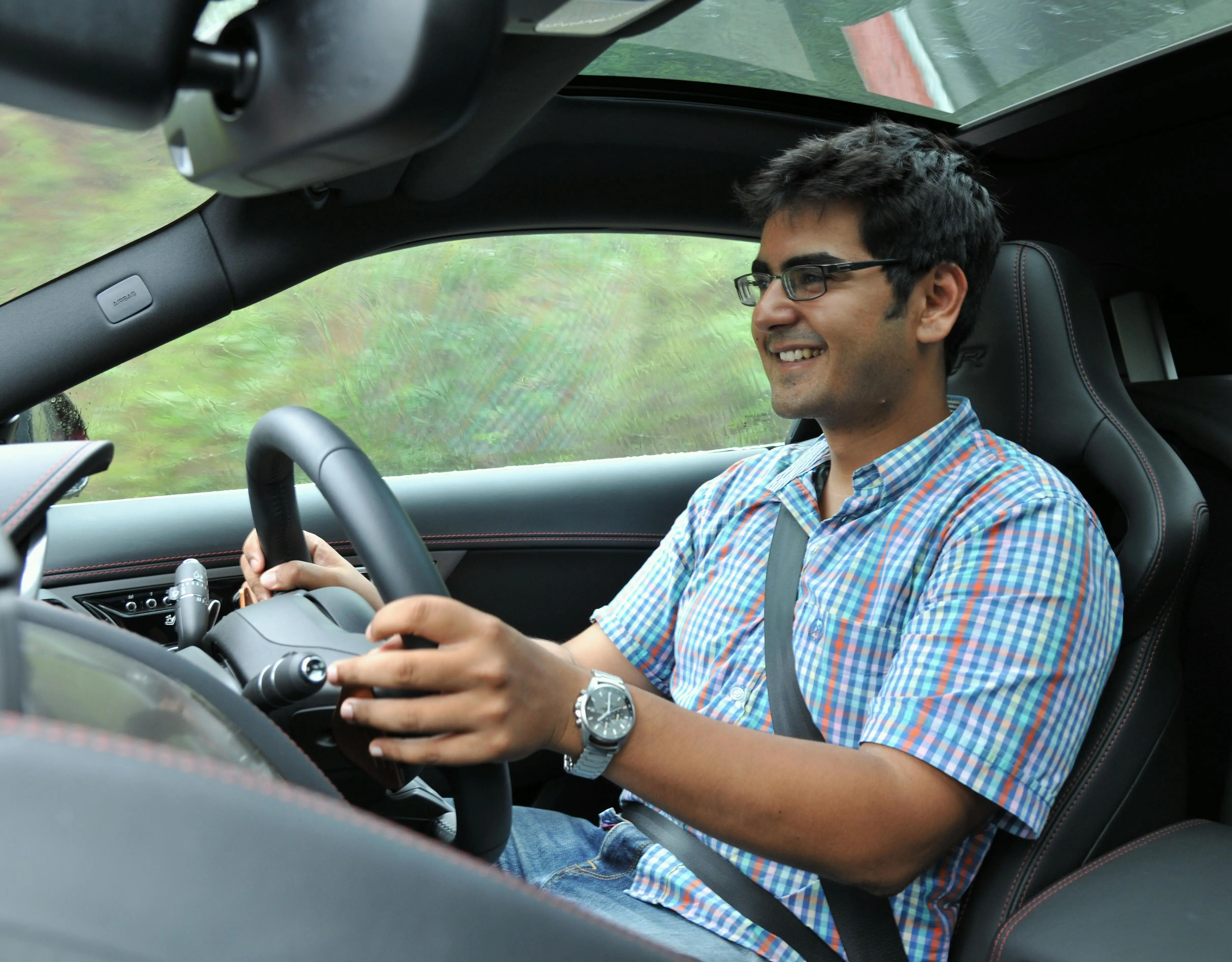
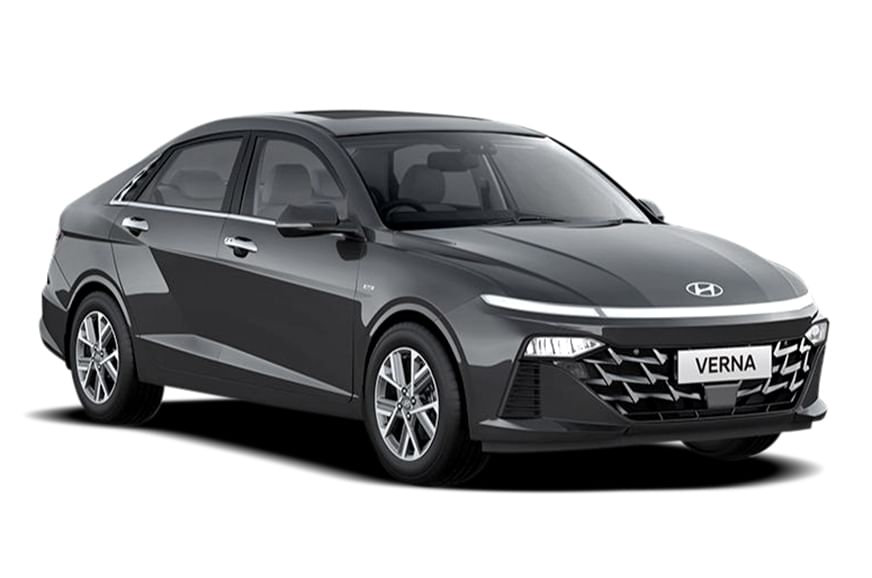


.jpg?w=234&h=156&q=90&c=1)



Comments
Member Login
Personal Details
No comments yet. Be the first to comment.